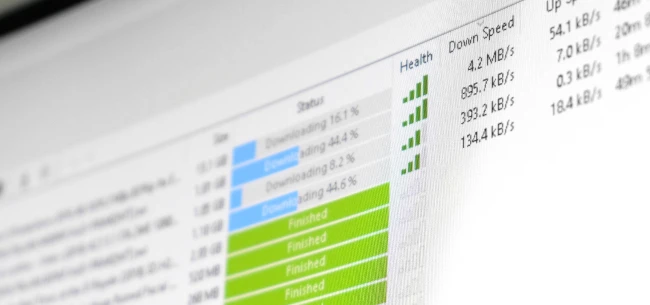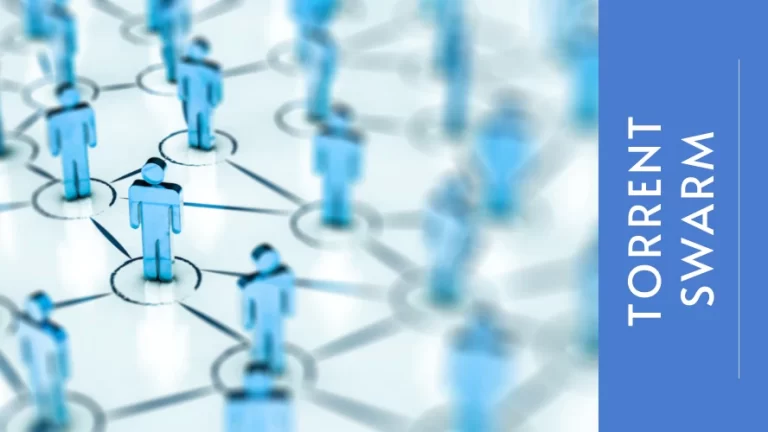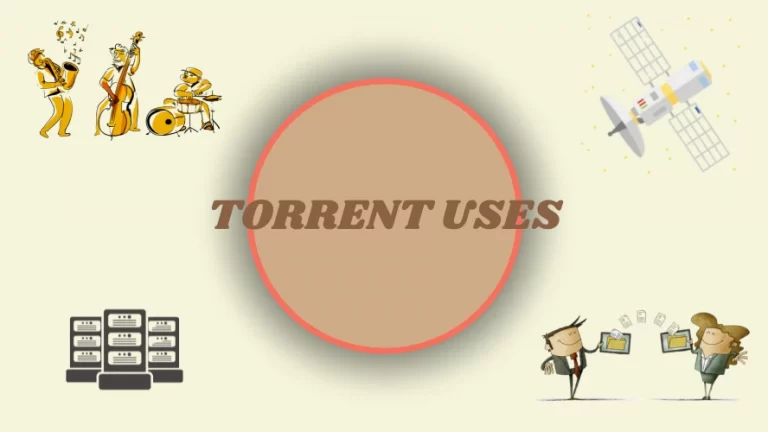Torrenting is a method of sharing large files over the internet. It uses a peer-to-peer (P2P) network architecture, where users (or peers) simultaneously download and upload. Shared files are divided into smaller pieces and distributed among multiple peers, who then share these pieces with each other.
Its main advantage is that it allows users to download from multiple sources at the same time. This decentralized nature of the torrent network makes it possible to transfer large files quickly and efficiently.
Since the appearance of the BitTorrent protocol, torrenting has become the most popular way for people to share files.
Different Uses of The Word “torrent”
Before we see how it works, let’s make sure you are familiar with the relevant terminology. The word torrenting and its derivatives can appear in different contexts. Let’s have a look at the most common ones.
What does the word “torrent” mean?
When used as a name, the word torrent usually refers to the .torrent file. That’s the small file that contains the information about the main file. Keep in mind that some people also use this word to refer to the file being downloaded. I usually use:
- Torrent (or torrent file): the small file opened by the BitTorrent client
- File: the main file downloaded by the BitTorrent client
As of 2018, “torrent” has been submitted to the McMillan Open Dictionary. Here’s how this dictionary defines it:
a file that contains information on how to transfer data between computers using BitTorrent protocol
McMillan Open Dictionary
This suggests that it may follow a path similar to “texting” or “googling” in the near future.
What does it mean “to torrent”?
Torrent is also used as a verb. When we say that we are torrenting a file, we can infer that we are downloading and seeding it. In other words, we are receiving and sending data at the same time.
More than two decades ago, we would have referred to this action as file sharing, which would still be correct today; torrenting is a way of sharing files.
How Does Torrenting Work?
The simple answer is that when torrenting, a file is broken down into smaller pieces and distributed among multiple users. As each piece of the file is downloaded, the torrent software also begins to upload that piece to other users.
To better understand torrenting, it’s essential to comprehend the concept of peer-to-peer (P2P) file sharing.
Understanding the Peer-to-Peer Nature of Torrenting
P2P stands for peer-to-peer, and it’s the backbone of torrenting. It refers to a type of network architecture in which each node (or peer) has equal capabilities and can act as both a client and a server. It is a decentralized network structure where no central server controls the flow of data. Instead, all nodes can communicate directly with each other and exchange information without the need for intermediaries.

This way, the burden of downloading a large file is shared among multiple users. As a result, it is faster and more efficient than traditional file-sharing methods.
The BitTorrent Protocol
Torrenting and BitTorrent are often used interchangeably, but they are not the same thing. As many people, particularly those new to the concept, often mix them up, it is necessary to differentiate between the two terms.
Torrenting vs BitTorrent
Torrenting refers to the general process of sharing files using the P2P file sharing method. It’s a type of file sharing that allows users to exchange data over the internet in a decentralized manner.
BitTorrent, on the other hand, is a specific protocol for implementing P2P file sharing. It was created by Bram Cohen in 2001 and is one of the most popular methods for torrenting files today. It uses a combination of the .torrent file and tracker server to coordinate the distribution of files among peers in the P2P network.
So, while BitTorrent is one specific way of implementing torrenting, torrenting is a broader term that encompasses all methods of P2P file sharing, including BitTorrent. When people refer to torrenting, they are usually talking about the BitTorrent protocol. However, it is important to note that other torrent methods exist besides BitTorrent.
How does the BitTorrent Protocol work?
Similar to other P2P protocols, BitTorrent is decentralized. It connects peers through a .torrent file that gets in touch with a tracker. The protocol is tasked with creating a network between trackers and peers. Each time there is an instruction to download a file, your BitTorrent client connects to a torrent swarm.
Inside the torrent swarm, complex exchanges of information and data take place. But it’s easy to understand how it works; peers within swarms share information with the tracker regarding the file. That information lets the tracker know which pieces of the file each peer is missing and which pieces it already has.
That’s how the tracker instructs each BitTorrent client on what pieces to upload and download. It’s a two-way data transmission in which peers are simultaneously sharing and downloading.
The Role of .torrent Files, Trackers, and BitTorrent Clients
.torrent files, trackers, and clients are crucial to the functioning of the P2P network. These three elements work together to ensure the efficient sharing of files.
.torrent files
A .torrent file serves as a blueprint for downloading a specific file or set of files from other users (peers). It contains information about the file being shared, such as its name, size, and checksums. When users start torrenting, they first download the .torrent file and open it with a torrent program (client). A well-known example of such software is uTorrent.
To put it simply, the main job of the .torrent file is to provide information about the file being shared.
Trackers
Trackers are servers that help peers find each other and keep track of the availability of seeders and leechers for a specific file in the network. When a torrent client starts downloading a file, it sends a request to the tracker, which then responds with a list of seeders and leechers available. Thanks to the tracker, the client can connect with these peers and download the file pieces. The tracker also keeps track of the download progress for each peer and ensures that the pieces are being distributed fairly among all the users.
BitTorrent clients
Once the torrent software has connected with other peers, it starts to receive pieces of the file from them, and in return, it shares pieces with them as well. The torrent client will download all of the pieces of the file and put them together to form a complete file. Once the download is finished, it will continue sharing the file with others until you stop it.

Basically, this program implements the BitTorrent protocol and manages the actual downloading and uploading of the file.
Advantages of Torrenting
With such sophisticated file sharing technology, it’s no wonder that torrenting has become increasingly popular. The following are a few of the advantages that make it so attractive.
1. It’s a faster download method
One of the most significant advantages of torrenting is that it allows for the fast downloading of large files. Since the burden of downloading is shared among multiple users, downloading a file using torrents can be much quicker than downloading the same file from a single server.
Furthermore, unlike traditional methods, the files don’t need to be downloaded in a particular order. It does not matter if it’s the beginning or the end of the file; each piece is organized as it is downloaded, forming the complete file. That gives the P2P download more freedom and speed, as it is able to download what is immediately available.
2. Decentralization
Another advantage of torrenting is that it is decentralized, meaning that there is no central server controlling the flow of data. This makes torrenting resistant to censorship and less vulnerable to overloading, slowing down, and even downtime.
3. Ease of use
Compared to other methods of downloading content, torrenting does not require technical expertise. All that is needed is a BitTorrent client, which can be downloaded for free, and a reliable source of torrents.
Once these are in place, downloading content is as simple as selecting a file and clicking “download.” Additionally, torrents can be paused and resumed at any time, which is convenient for large files or users with limited bandwidth.
4. Diversity of content
The diversity of content that’s available is a big plus. With the increasing popularity of this file sharing method, many sources have begun offering their content via torrents. You can find everything from books and music to movies and software.
5. Companies and artists can take advantage of it
Companies and even governments use torrenting to distribute large files quickly and easily. Additionally, artists can use torrenting to share their work with a broader audience. This provides users and customers with a better way to access the content.
We wrote a post where we explore different ways torrents are used, to give you a better idea about the various applications this technology can have.
Disadvantages of Torrenting
Even though torrenting offers many benefits, it also has several disadvantages that are important to consider.
1. Visible IP address
The most cited drawback is that the protocol requires you to share your public IP address with the rest of the network, including the torrent tracker. Torrenting is anonymous in the sense that you do not have to register on the network personally.
However, your IP address could be a stepping stone for others in the swarm to start sleuthing and figuring out some of your personal information.
A VPN is the most common tool used to avoid that situation. It hides the IP and encrypts the downloaded data. That way, others will not know what you are downloading or sharing. Here are a few VPNs that do a good job when it comes to torrent downloads:
2. Legal Issues
Torrenting can be illegal in some countries if used to download copyrighted material without permission. This has led to high-profile legal cases and made many people hesitant to use torrents.
3. Bandwidth Limitations
Torrenting can also put a strain on your internet connection, as uploading and downloading large files can consume a lot of bandwidth. This can lead to slower speeds for other internet activities. For users that don’t have an unlimited plan, it can even result in overage charges from the ISP.
A good way of circumventing that is to limit the client’s download and upload rate. It will provide more bandwidth for the remaining online activities.
4. Quality Control
With torrenting, the quality of the file you receive can be unpredictable, as it depends on the quality of the file uploaded by other users. This can sometimes lead to low-quality or corrupted downloads.
5. Other security risks
Occasionally, a virus may hide in a torrent file when downloading from untrusted sources. Antivirus software and other security applications can mitigate this risk. It’s also good to read the comments on the torrent’s page to see if other users point out any danger connected to that particular file.
Is Torrenting Legal?
The act of torrenting or sharing digital files is legal. We can say the same about the underlying technologies such as BitTorrent. The legal issues associated with torrenting start when people use it to download copyrighted content. However, remember that, in such situations, it’s not the act of torrenting itself that is illegal, but rather the distribution of the copyrighted material.
Ever since P2P protocols were released, there has been discussion about how they can be conducive to online piracy. The first considerable controversy about sharing copyrighted content was the Napster scandal. If you don’t know, Napster was brought down in a California federal court with a lawsuit filed by legendary rock band Metallica in 2000.
This marked the beginning of many legal fights between file sharing entities, governments, and copyright groups.
Can someone be sued for torrenting
Yes, it is possible for someone to be sued for torrenting copyrighted material without permission. This can happen if the copyright holder discovers that their content is being shared without authorization. And, of course, if they can prove a user downloaded the content in question.
It varies from place to place, but some countries have harsh laws for copyright infringement. In some cases, consequences can range from monetary damages to criminal penalties.
Many countries have agencies dedicated to tracking “pirates” and fining them a fixed amount per instance. But that varies widely across the globe, with countries like Germany mass-fining P2P pirates and Canada essentially taking a hands-off approach.
Who is Targeting Torrent Users?
The MPAA and the RIAA are the two groups that have fought the hardest against those who downloaded copyrighted material.
The Motion Picture Association of America (MPAA)
In addition to setting ratings in the United States for certain movies, the MPAA is essentially a movie creators’ union representing the common interests of those in the industry.
One of those interests happens to be retaining studios’ intellectual property rights. The MPAA has gone after those who upload and download files containing their copyrighted content. Unfortunately, these lawsuits are expensive for the average person.
Recording Industry Association of America (RIAA)
This group represents musicians and music studios. They’re notorious for filing countless lawsuits against people for pirating even single songs without permission. After making too many headlines, the group has relaxed its stance.
Nonetheless, they continue to monitor torrent swarms and record IP addresses found to be engaging in piracy.
Joint MPAA / RIAA Efforts

These two groups have teamed up to take down websites dedicated to piracy. Now, they’re not going after individual BitTorrent users nearly as much as they used to.
However, they’re heavily attacking file lockers and torrent sites known to link to copyrighted media. They managed to have a few closed.
What Is the Future of Torrenting?
Even though torrenting is far from dying, it keeps facing challenges.
In recent years, there has been a rise in the popularity of paid streaming services like Netflix, Hulu, and Amazon Prime Video. These legal platforms allow users to access a vast collection of movies and TV shows for a monthly subscription. As a result, many individuals are opting for the convenience of these services instead of torrenting.
In addition, some countries are implementing laws and regulations that make it more difficult to use BitTorrent. Examples include:
- Blocking access to torrent websites.
- Monitoring user activity.
- Imposing fines and other penalties on users who engage in illegal file sharing.
Despite all the obstacles it has faced since the start, torrenting remains a popular and widely-used file sharing method. I don’t think any other technology will take its place.
Sure, new platforms have their share, but torrenting will always have a wide audience. It will inevitably be the first choice of users who value the highest quality and also the users who want to keep the file, as opposed to what streaming offers.



